March 1, 2013 Water Supply Forecast Discussion
The Colorado Basin River Forecast Center (CBRFC) geographic forecast area includes the Upper
Colorado River Basin, Lower Colorado River Basin, and Eastern Great Basin.
Seasonal Water Supply Forecasts:
Quick Summary: Forecasts generally decreased over the entire CBRFC area.
Below to much below average spring and summer April-July streamflow volumes are forecast throughout
the Upper Colorado River Basin and Great Basin. Much below median March-May volumes are
expected in the Lower Colorado River Basin.
The highest runoff volumes relative to average are expected in the San Juan Basin. Lowest runoff volumes
relative to average are fairly widespread and include the Gunnison River Basin, Lower Green River Basin,
Little Snake River Basin, Weber River Basin, and inflow to Lake Powell. For these areas the forecast April-July
volumes are generally less than 55 percent of average.

Image: River basin map for the April-July runoff forecast period. Forecasts are expressed as a percent of average.
The Little Colorado, Salt, and Verde Basins (not displayed) are forecast for less than 50% the March-May median.
Click here for specific site water supply forecasts
Water Supply Discussion
Weather Synopsis:
February began with a stagnant weather period dominated by high pressure, valley temperature
inversions, and mostly dry weather. The weather pattern evolved to a more progressive one as a
northwesterly flow developed bringing occasional storms. The track of each storm varied with precipitation
occurring across the entire forecast area during the month, however no one particular area was favored.
This resulted in February recording below average precipitation throughout the CBRFC region.

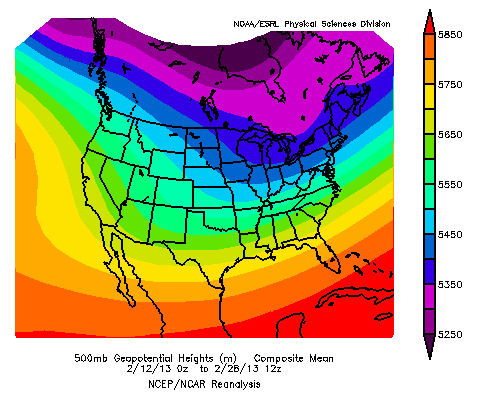
Image: Mean upper air pattern over the continental U.S. for February 2013. Stagnant weather conditions
during the first part of the month gave way to a more progressive pattern and increased storminess.
Precipitation and Temperature:
February ended up as another dry month over the vast majority of the CBRFC region, particularly in the Upper
Green River Basin, Duchesne River Basin, part of the northern Great Basin, and the Virgin River Basin.
Precipitation in these areas was generally less than 50 percent of average for the month. Seasonal
October-February precipitation in the water supply producing areas is generally 70-90 percent of average.
This below average area has expanded to include more of the Great Basin. There has also been some increase
in areal extent where seasonal precipitation is below 70 percent of average.

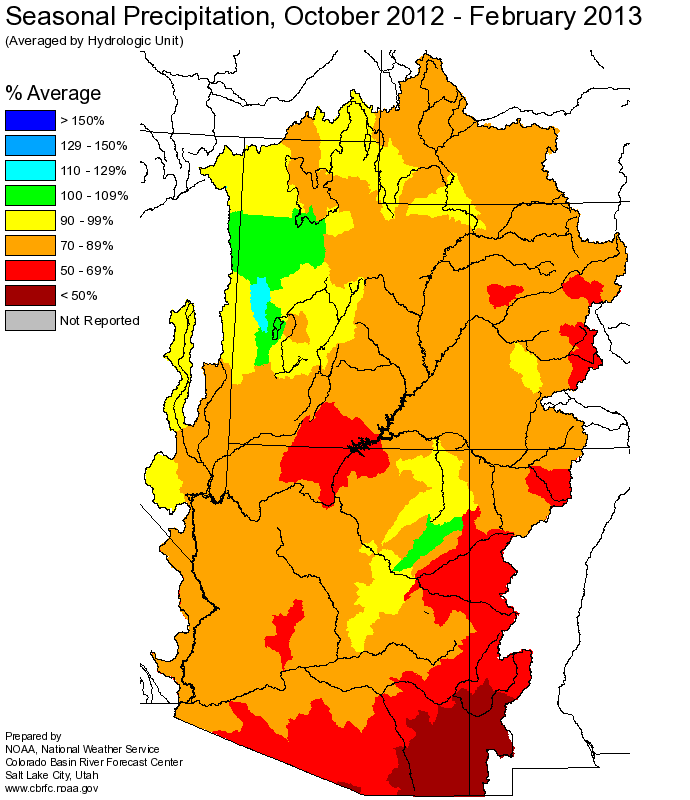
Similar to January, temperatures in February were below average over the entire CBRFC area. The greatest
departures from average were also in northern valley areas due to the presence of inversions.
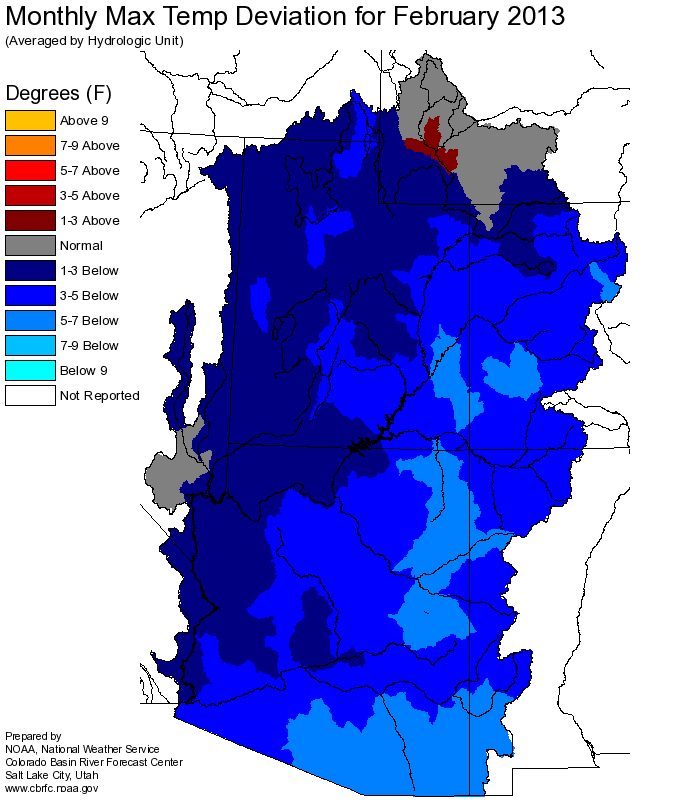
Image: February 2013 temperature departure from average.
Snowpack:
With below average precipitation in February, snow conditions continued to fall further behind the average
for this time of year. Several additional SNOTEL sites have fallen into the below 75 percent of average
category between February 1st and March 1st. As of March 1st the majority of SNOTEL sites in the CBRFC
forecast area are below average
The map below is a display of Snow Water Equivalent (SWE) at SNOTEL sites as a percent of the 1981-2010 average.

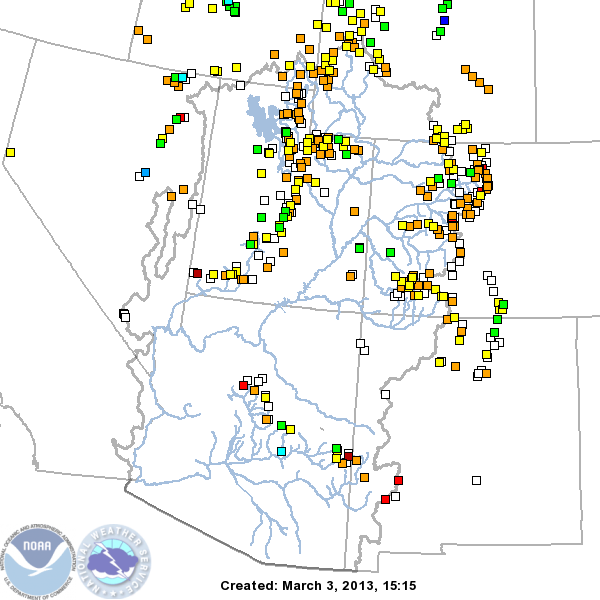
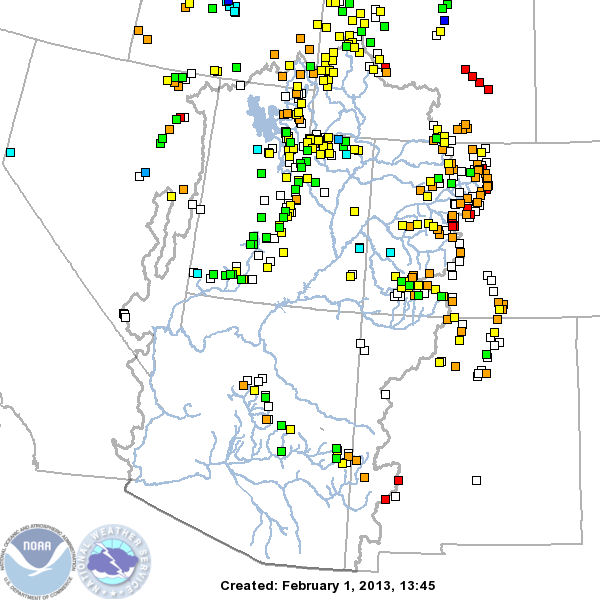
Image: CBRFC Snow Conditions Map as a percent of average for March 2013 and February 2013
SNOTEL sites in the the Roaring Fork, Blue,and Eagle River Basins continue to record some of the lowest values
for their respective periods of record (red sites on the map below). Several other sites are in the bottom 10 percent
of record (orange on the map). Most SNOTEL sites in this area have periods of record around 30 to 35 years
so they rank near the 2nd or 3rd lowest for this time of year. These conditions are beginning to show up in the
northern Great Basin, with a couple sites now at their lowest values on record and several others in the bottom
10 percent of their historical records.

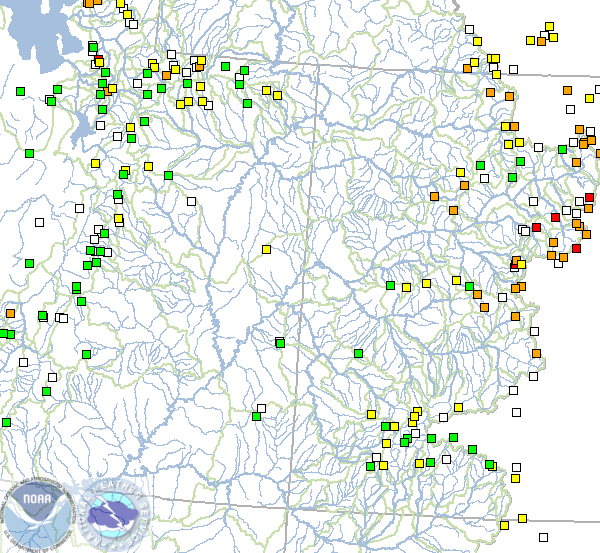
Image: CBRFC Snow Percentile Map - sites ranked based on historical record. Sites in red are the lowest for
their respective period of record. Sites in orange are in the bottom 10 percent of their historical record.
Click here for river basin snow plots
Soil Moisture:
Soil moisture conditions in the higher elevation headwater areas are important entering the winter,
prior to snowfall, as it influences the efficiency of the snow melt runoff. Last fall, modeled soil moisture
conditions were below average throughout the upper and lower Colorado Basins. In northern Utah, modeled
soil moisture was closer to average in parts of the Bear, Weber, Provo, Six Creeks, and Duchesne Basins
due to the late October storm and high elevation rainfall. This is also true for some of the upper Green
River Basin headwaters in Wyoming. The generally dry soil moisture conditions elsewhere have influenced
the latest water supply forecasts resulting in a 5-15 percent reduction in the forecast volumes. See the map below
for a more detailed view.
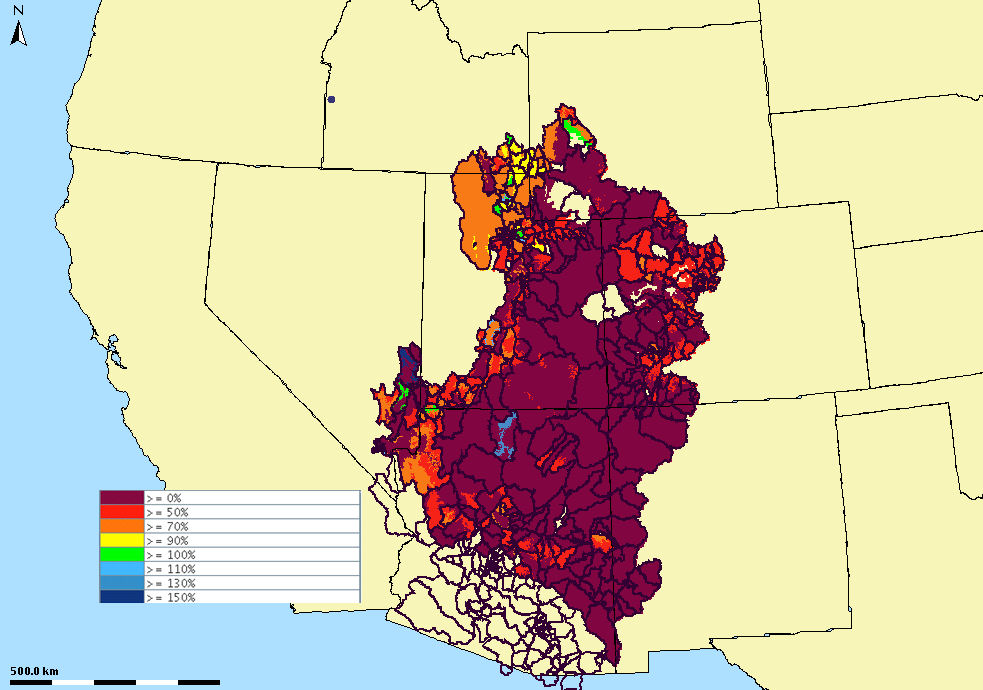
Image: Modeled soil moisture states (as a percent of average) on Dec 31 2012
Streamflow:
Monthly streamflow volumes throughout the CBRFC area in February of 2013 have generally been much below average
due to the dry conditions that extend back to the spring of 2012.
Climate Outlook:
The El Nino Southern Oscillation (ENSO) condition is considered neutral and this is expected to continue
through the northern hemisphere summer of 2013. The Climate Prediction Center indicates increased chances for
below average precipitation during the March through May period over the entire CBRFC forecast area.

Image: Climate Prediction Center 3 month precipitation outlook
Conclusion:
Near record low runoff volumes occurred in the spring of 2012 across much of the forecast area. Very dry
conditions with much below average precipitation occurred over most of the area during the September through
November period. This has resulted in much below average modeled soil moisture conditions.
Mild temperatures during the fall also resulted in rainfall with initial storms instead of accumulating snow
at higher elevations. Snow is generally much below average throughout the forecast area and snowpack conditions
deteriorated further during the month of February. As a result streamflow volumes are forecast to be
below to much below average as of March 1st.
End Of Month Reservoir Content Tables
Green River Basin
Upper Colorado River Basin
San Juan River Basin
Great Salt Lake Basin
Sevier Basin
Lower Colorado Basin
Basin Conditons and Summary Graphics
Green River Basin
Upper Colorado River Basin
San Juan River Basin
Great Salt Lake Basin
Sevier River Basin
Lower Colorado Basin
Definitions
10% exceedance forecast: Given the current hydrometeorological conditions, i.e current snowpack, soil moisture and streamflow, the volume that has a 10% chance of being exceeded. Previously referred to as "Reasonable Maximum Forecast".
50% exceedance forecast: Given the current hydrometeorological conditions, i.e current snowpack, soil moisture and streamflow, the volume that has a 50% chance of being exceeded. Previously referred to as "Most Probable Forecast".
90% exceedance forecast: Given the current hydrometeorological conditions, i.e current snowpack, soil moisture and streamflow, the volume that has a 90% chance of being exceeded. Previously referred to as "Reasonable Minimum Forecast".
Acre-Foot (af):
The volume equal to one acre covered one foot deep (43,560 cubic feet). See kaf below.
Average:
The arithmetic mean. The sum of the values divided by the number of values. Values from 1981-2010 are used for this publication.
Categories:
Much Above Average=Greater than 130%, Above Average=111-130%, Near Average=90-110%, Below Average=70-89%, Much Below Average=Less than 70%.
CBRFC:
Colorado Basin River Forecast Center.
Forecast Period:
The period from April 1 through July 31, unless otherwise noted.
kaf:
Thousand Acre-Feet. See Acre-Foot above.
Inflow:
The volume of water that flows into a reservoir or lake.
Median:
The middle value of an ordered set of values. Half of the values are higher and half of the values are lower. When the set contains an even number of values the median is the average of the two middle numbers.
NOAA:
National Oceanic and Atomospheric Administration.
NWS:
National Weather Service.
Rounding Conventions:
| Range | | Round to |
| 0-1.99 | | 0.01 |
| 2.0-19.9 | | 0.1 |
| 20-199 | | 1.0 |
| 200-999 | | 5.0 |
| 1000+ | | 3 significant digits |
Streamflow:
The volume of water that flows past a specific stream site.
Water Year:
The 12-month period, October 1 through September 30. The water year is designated by the calendar year in which it ends. Thus, the year ending September 30, 2008, is called the "2008 water year."
Additional Information
Water supply forecasts take into consideration present hydrometeorological conditions and use
average basin temperatures and precipitation for the forecast period. As the forecast season progresses,
a greater portion of the future hydrologic and climatic uncertainty becomes known and
monthly forecasts become more accurate. For more information on the tools we use, consult
Water Supply Forecasting Tools.
Volume forecasts represent adjusted flows; that is, observed flows with upstream water use
taken into account. Adjusted flows will closely approximate natural or unimpaired flows.
However, not all upstream diversions or impoundments are measured or quantifiable. For specific
adjustments used with each forecast point, consult the
Guide to Water Supply Forecasting.
The Water Supply Outlook is issued monthly January through May by the Colorado Basin River
Forecast Center. It represents a coordinated effort between the
National Weather Service, Natural Resources Conservation Service, Bureau of Reclamation, U.S.
Geological Survey and local water district managers.
Note: Data used in this report are provisional and are subject to revision.
For more information, or to be included on the mailing list, please contact:
Colorado Basin River Forecast Center
2242 W North Temple
Salt Lake City, UT 84116
(801) 524-5130
www.cbrfc.noaa.gov












